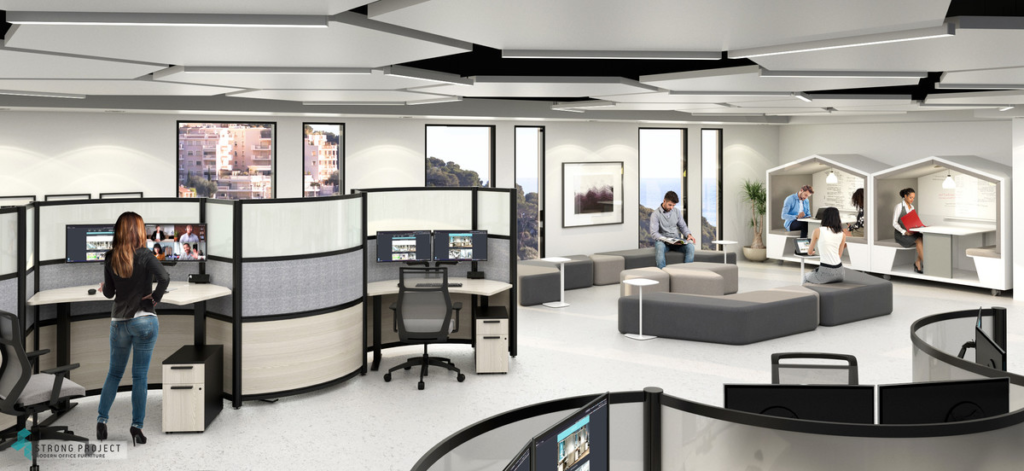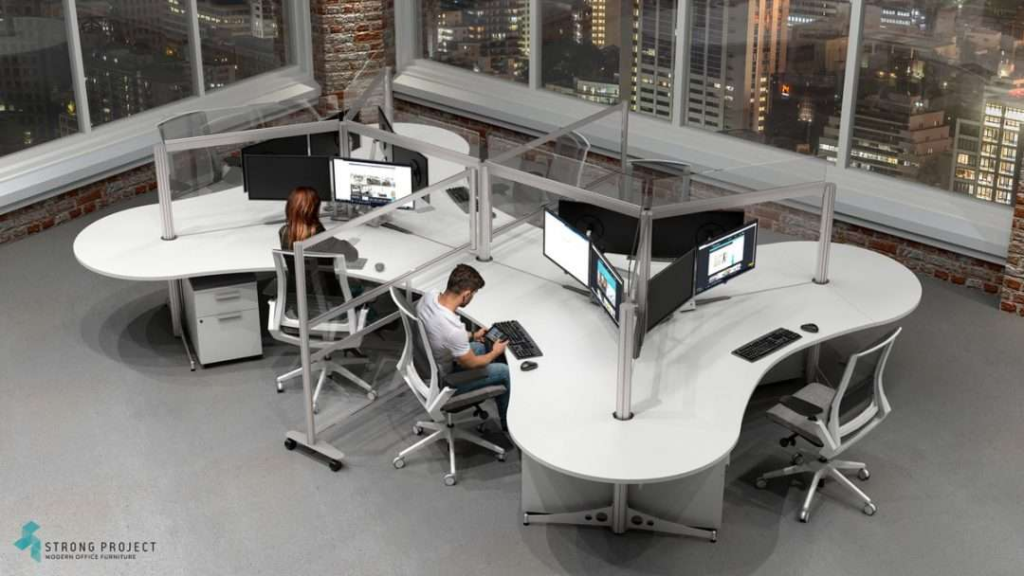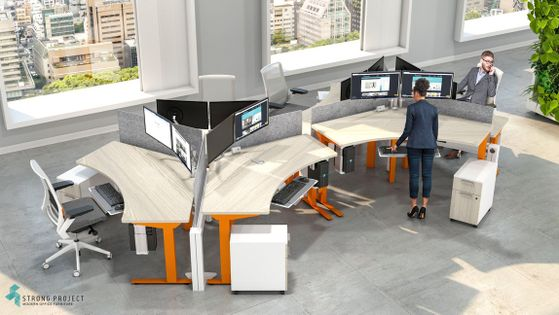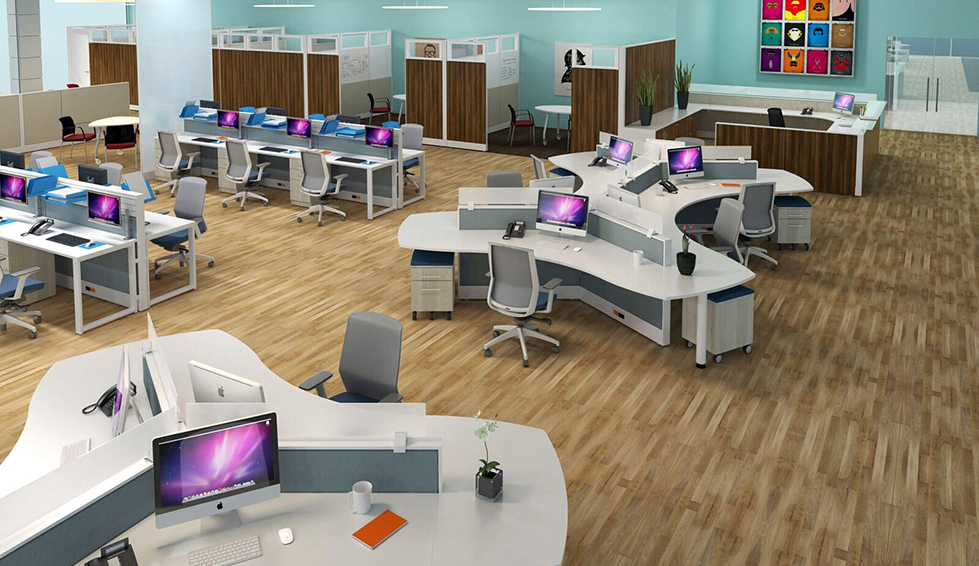Creating productive office cubicles is an art and a science. How can you design cubicles that boost creativity and efficiency? Office cubicle design impacts both productivity and employee satisfaction.
A well-designed cubicle is more than a workspace. It provides comfort, focus, and motivation. Small changes can enhance productivity.
Good lighting, comfy chairs, and smart storage matter. Offices cubicles should reflect the company’s culture and values. Consider noise levels when planning your office layout.
Think about flexibility and personalization options. Employees work best in spaces that suit their needs. Let’s explore the elements of designing effective cubicles.

Understanding the Basics of Cubicle Design
Office cubicles are individual work areas within a larger office space. They consist of three walls and an entrance for employees to enter and exit.
Cubicles provide privacy for employees. They still allow individuals to be part of the office environment.
Cubicle design should start with understanding the needs and preferences of your employees. What type of tasks do they perform? Do they need ample desk space or more storage?
Is natural light important to them? Gathering this information will help you create a customized cubicle. It will ensure that it meets their specific needs.
Benefits of Well-Designed Cubicles
Well-designed cubicles can have a significant impact on productivity and employee satisfaction. Here are some key benefits of investing in good office cubicle design:
Increased Productivity
Cubicles designed with productivity in mind can boost an employee’s work output. By providing a designated workspace, employees can cut distractions.
It allows them to maintain focus on their tasks. Simple elements that contribute to a better workflow, such as:
- good lighting
- comfortable seating
- organized storage solutions
When employees have everything they need, they can work more efficiently and effectively. Personalized touches in a cubicle can inspire creativity and motivation. It leads to an increase in productivity.

Better Use of Space
Optimizing office space is vital for creating a conducive work environment. Well-designed cubicles allow for better use of available space by arranging workstations. It cuts the number of employees they can accommodate without feeling cramped.
It helps keep the office organized. This ensures that each employee has a defined area to perform their tasks.
Creative layouts and modular designs can adapt to various office sizes. It makes it possible to use space, leading to a better workspace.
Cost-effective Solution
Investing in office cubicles can be a cost-effective solution for organizations. This approach helps create an efficient workspace without overspending.
Choosing a used cubicle or seeking out cubicles for sale can reduce setup costs. This option still offers quality workstations for your needs.
These pre-owned options offer the same functionality and flexibility as new cubicles. Yet, they come at a fraction of the price.
Purchasing used cubicles contributes to environmental sustainability by reducing waste. It also promotes resource reuse.
With smart, budget-conscious choices, firms can create a productive office environment. It can be achieved without breaking the bank.
Improved Employee Satisfaction
A well-thought-out cubicle design plays a role in boosting employee morale and satisfaction. When employees have a comfortable and efficient workspace, they feel valued and appreciated. This sense of being cared for can reduce stress levels and increase job satisfaction.
Personalization of their own space allows employees to express their individuality. It elevates their comfort and fosters a positive work attitude.
Satisfied employees are more committed and tend to stay longer with the company. This benefits themselves and the organization.
Flexibility
Flexibility is a key factor when designing office cubicles. It accommodates diverse work styles and preferences.
Modular cubicles can reconfigured to suit changing team sizes or office layouts. It ensures that the workspace evolves with the company.
Employees enjoy the flexibility to personalize their areas. It allows them to include items that boost their productivity or comfort.
This adaptability allows the business to respond swiftly to change. It supports employees by providing a space that meets their evolving needs. This environment enhances their work-life balance.

Key Considerations in Designing Productive Cubicles
When designing productive office cubicles, there are a few key factors to remember. These include:
Comfort
Employees spend an amount of time at their desks, so it’s vital to make sure they are comfortable. A good chair with proper back support and adjustable height is essential. Desk surfaces should also be at the appropriate height for typing and writing.
Lighting
Natural light has been linked to increased productivity and well-being. Where possible, try to incorporate natural light into the design of your cubicles. If this is not feasible, invest in good quality artificial lighting that is easy on the eyes.
Storage
Clutter can be distracting and hinder productivity. Provide enough storage options for employees to keep their workspace organized. It can include:
- shelves
- drawers
- filing cabinets
Noise levels
Consider the noise levels in your office when designing cubicles. Engage in sound-absorbing materials such as:
- acoustic panels
- rugs
It helps reduce noise distractions. Investing in these solutions can enhance focus and productivity.
Personalization
Let workers personalize their cubicles with items like photos or plants. It can create a sense of ownership and pride in their workspace. Encourage employees to decorate their spaces in a way that inspires them.
Innovative Cubicle Layout Ideas for 2024
The world of work is evolving, and so are office cubicle designs. Here are some innovative ideas to consider for your office layout in 2024:
Collaborative Cubicles
Collaborative cubicles foster teamwork and open communication among employees. These cubicles feature low partitions that help interaction among team members. Some areas even offer shared cubicle workstation setups, promoting collaboration.
The open layout breaks down barriers and encourages an exchange of ideas. It leads to increased creativity and innovation.
Providing spaces with flexible seating can adapt to various teamwork needs. Small meeting areas within the cubicle setup further enhance collaboration.
This design promotes a sense of community. It shared goals while maintaining individual work zones.
Wellness-Focused Cubicles
Wellness-focused cubicles focus on the health and well-being of employees. These workspaces are designed with ergonomics in mind. They offer furniture that supports good posture and reduces strain.
Natural elements are incorporated to create a relaxing atmosphere. Access to natural light and good air quality are vital in these cubicles.
By focusing on wellness, employers can enhance employee satisfaction and reduce stress. A healthy workspace encourages mindful work habits. It impacts productivity and happiness.
Multi-functional Cubicles
Multi-functional cubicles are all about versatility and adapting to different work needs. These cubicles are equipped with adjustable furniture that can be easily reconfigured. It allows employees to quickly transition between tasks.
With built-in storage solutions and foldable desks, one space can serve multiple purposes. They cater to various work styles. It offers the flexibility needed in the work environment.
These cubicles maximize functionality, making the most of limited space. They also support diverse tasks efficiently.
Outdoor-Inspired Cubicles
Bringing the outdoors inside, outdoor-inspired cubicles aim to incorporate nature into the workplace. These cubicles feature natural materials like:
- wood
- stone
Green plants are included to enhance air quality and boost morale. Large windows or virtual displays of scenic views create an open, airy feel.
These elements can reduce stress. They foster creativity by making employees feel connected to the natural world.
Outdoor-inspired designs break the monotony of traditional office settings. It creates a refreshing and invigorating workspace.
Tech-Integrated Cubicles
Tech-integrated cubicles incorporate technology to enhance work efficiency and connectivity. These cubicles feature built-in charging ports, smart screens, and wireless device setups. They enable easy access to digital tools and facilitate virtual meetings and collaboration.
With smart sensors, these workspaces can adjust lighting and temperature. It tailors the environment to an employee’s comfort.
By merging technology with workspaces, tech-integrated cubicles support a modern and connected workforce. It ensures employees have everything they need at their fingertips.
Customization Options for Office Cubicles
Customization is key when it comes to designing productive office cubicles. Here are some customization options to consider for your workspace:
Height-Adjustable Desks
Allow employees to switch between sitting and standing throughout the day. Height-adjustable desks make this possible. It promotes movement and reduces the negative effects of prolonged sitting.
Height-adjustable desks can also accommodate employees of different heights. It ensures everyone has a comfortable and ergonomic workspace.
Color and Design
Incorporate calming colors to create a more relaxed atmosphere. Use energizing colors to boost productivity. Consider using company colors or patterns to reflect the organization’s brand and values.
Ergonomic Accessories
Provide ergonomic accessories like wrist pads and footrests to promote proper posture. Monitor stands can also help reduce strain on the body. These small adjustments can have a big impact on employees’ comfort and productivity.
Personalized Storage Options
Give employees the option to choose their preferred storage solutions. It allows them to select options based on their individual needs.
It can include lockable drawers, open shelves, or hanging file organizers. It allows for a more efficient and organized workspace.
Implementing Effective Cubicle Designs
Creating productive office cubicles requires careful planning and execution. Here are some key steps to follow when implementing your design:
Start With a Layout Plan
Creating a successful cubicle design begins with an effective layout plan. Start by measuring your office floor space to understand the available area.
Think about how many cubicles you need and ensure enough room for each. It’s vital to leave paths between cubicles so employees can move around easily.
Consider the location of the windows. It will allow natural light to reach as many workstations as possible.
Plan the layout to cut noise and distraction factors. Place collaborative workspaces away from quieter, focused work areas.
A good layout creates a balanced environment. It promotes productivity and comfort for everyone.

Consider Traffic Flow
When designing an office with cubicles, it is vital to think about how people will move around the space. Good traffic flow helps everyone access their desks easily. It prevents bumping into others and reduces congestion in tight areas.
Make sure there are clear paths for walking that are wide enough for employees to pass each other. It’s vital to place main paths away from busy areas like meeting rooms or restrooms. It is to avoid interference with those needing a quiet workspace.
Mark emergency exits clearly and keep them accessible at all times. Proper traffic flow makes the office safer. It improves the atmosphere by reducing stress and promoting smooth movement.
Test Run Your Design
Before finalizing your office cubicle design, it’s vital to test-run your setup. Start by setting up a few cubicles exactly as planned.
Then, ask a small group of employees to use them for a few days. This hands-on trial will help you see if the layout works well for daily tasks.
Pay attention to feedback on comfort, ease of movement, and available space. Make sure natural light reaches their workspace and noise levels are tolerable.
Testing your design allows you to identify potential problems. These issues may not have been obvious during the planning stage. Use this opportunity to make adjustments before enforcing the final design.
Regularly Assess and Adapt
Keeping office cubicle designs helpful and efficient requires regular assessment and adaptation. As time passes, the needs of the office and its people may change. It is vital to check if the current setup still meets those needs.
Start by gathering feedback from employees. Find out what works and what does not in the current cubicle layout. Look for any issues with comfort, noise, or accessibility.
Once the feedback is in, make small adjustments to improve the workspace. It could mean:
- rearranging furniture
- adding more storage
- improving lighting
Regularly assessing and adapting helps create a flexible work environment. This continued evolution supports productivity and employee satisfaction.
Learn More About Designing Productive Offices Cubicles
Efficiently designed office cubicles play a crucial role in productivity. They create a comfortable workspace that boosts employee morale.
Personalization options allow staff to tailor their spaces to their needs. Ergonomic features enhance comfort and improve health. Regular assessment ensures the design evolves with changing requirements.
By implementing strategic layout plans, firms can maximize space. Adjustable cubicle features lead to a dynamic work environment. Well-planned offices cubicles support a harmonious, productive, and satisfied workforce.
Did you find this article helpful? If so, check out the rest of our site for more informative content.







